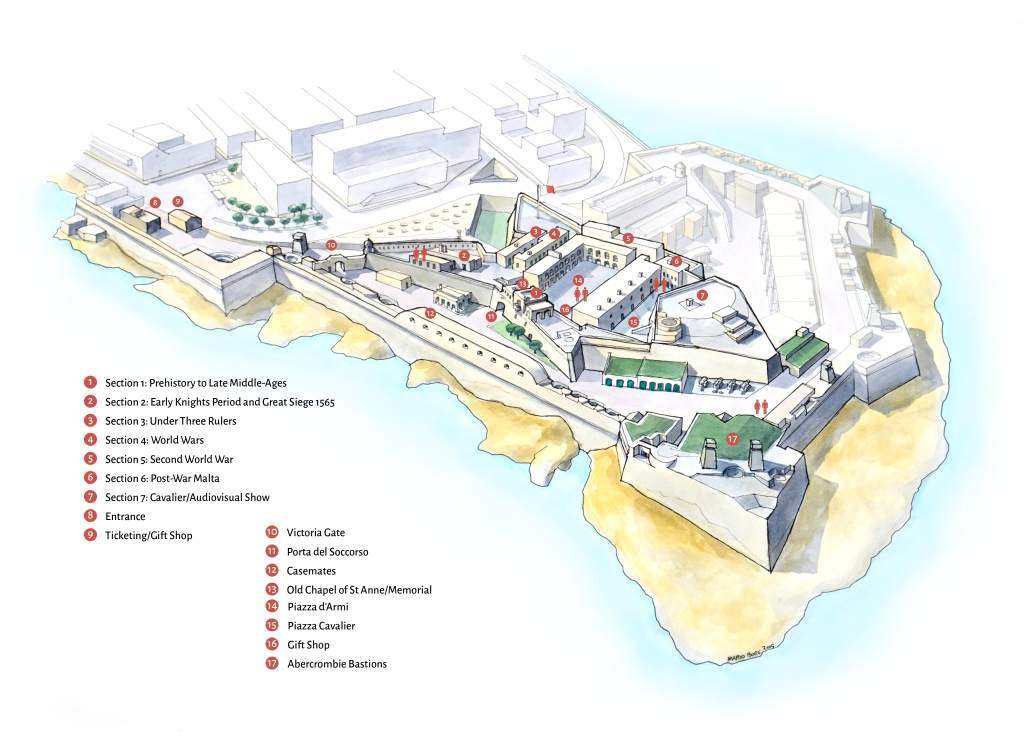Originally intended as a war machine, the fort was built in a strategic location at the tip of the Sceberras peninsula to face and hold back the wrath of the Ottoman armada. Offering unobstructed panoramic views of the harbours and the surrounding towns and villages, this key position was already recognised and exploited during the Medieval period. Reference to a permanent watch-post at Santo Eramo can in fact, be found in the Militia Roster of 1417. Following a harsh Ottoman razzia in 1551, and various reports indicating a looming Ottoman siege, Grand Master De Homedes issued an order for the immediate erection of a fort.
A star-shaped fort was constructed in 1552, by military engineer Pietro Prato, under the supervision of Knight Fra Leone Strozzi. By 1565 the fort had acquired a cavalier, a covertway, a terraille, and a ravelin which was hastily built in a few months.
Fort St Elmo received the brunt of the Ottomans’ forces, who besieged Malta in 1565. Against all odds, the small fort resisted for a month, surrendering on 23 June. The 17th and 18th centuries witnessed several additions, including barracks, church and a lighthouse. The whole fort was included within Valletta’s fortifications in 1689.Under British rule Fort St Elmo was extensively upgraded for new artillery and even played an important role in the defence of Malta during the Second World War. On 11 June 1940, Fort St Elmo suffered the first aerial bombardment on the islands. Its active role in sieges and battles made it ideal for the hosting of a National War Museum.
Visitors at Fort St Elmo can experience the impressive grounds of the fort, including the splendid architecture of the two chapels dedicated to St Anne. The National War Museum, is divided into seven sections and covers 7,000 years of Maltese Military History from the Bronze Age until Malta’s accession in the EU. Notable artefacts include military armour of the Order of St John and the Ottoman Turks. However, the Second World War is the most represented conflict in the museum. Highlights include the Gloster Sea Gladiator N5520 FAITH, Roosevelt’s Jeep ‘Husky’, and Malta’s award for gallantry, the George Cross. Within the museum, a separate War Memorial contains a repository of the many medals bestowed in recognition of bravery and merit during the war effort.


Fort St Elmo and the National War Museum
Museum, Fortification
Click link below for opening hours:
In Guardia - Sundays - As per Schedule: 11.00 am - 12.00 pm
Fort St Elmo And National War Museum, Valletta, Malta
Adults (18+): €10.00
Senior Citizens (60+): €7.50
Youths (12-17): €7.50
Concessions & Students: €7.50
Children (6-11): €5.50
Infants (1-5): Free
Heritage Malta Members: FREE
Heritage Malta Passport Holders: FREE
Gallery
Virtual Experience
Getting Here
Public Transport
The closest bus stop is 10 minutes on foot. Interested in getting here by public transport?
Plan your journeyRequest A Guided Tour
Thank you for your interest. Please complete the form below and we’ll look to get back to you as soon as possible.

Frequently Asked Questions
Answers to the most common questions about the National War Museum and the Fort St. Elmo.
Yes.
We recommend to dedicate at least 1.5 hours to have a good glimpse of both Fort and Museum.
Photography is allowed without flash.
Yes, the site is equipped with chair lifts.
Visitors can see beautiful vies of both harbours surrounding the city of Valletta.
Fort St Elmo houses the National War Museum which focuses on Malta’s military history from prehistory until the 20th century.